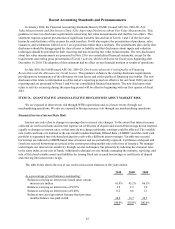Cabela's 2010 Annual Report Download - page 82
Download and view the complete annual report
Please find page 82 of the 2010 Cabela's annual report below. You can navigate through the pages in the report by either clicking on the pages listed below, or by using the keyword search tool below to find specific information within the annual report.72
CABELA’S INCORPORATED AND SUBSIDIARIES
NOTES TO CONSOLIDATED FINANCIAL STATEMENTS
(Dollars in Thousands Except Share and Per Share Amounts)
Revenue from the sale of gift certificates, gift cards, and e-certificates (“gift instruments”) is recognized in
revenue when the gift instruments are redeemed for merchandise or services. The Company records gift instrument
breakage as revenue when the probability of redemption is remote. Historically, the Company recognized breakage
seven years after the issuance of a gift certificate or gift card. In the fourth quarter of 2008, the Company began
recognizing breakage on gift instruments four years after issuance as a result of changes in trends in the types of
gift instruments issued and the related redemption rates. The impact of the change in estimate in the fourth quarter
of 2008 was an increase in revenue and operating income of $8,702. Total gift instrument breakage was $4,839,
$4,522, and $10,152 for 2010, 2009, and 2008, respectively. Cabela’s gift instrument liability at the end of 2010 and
2009 was $110,791 and $103,305, respectively.
Financial Services revenue includes credit card interest and fees relating to late payments, over limit,
payments made with a customer service representative, returned check, payment assurance, foreign currency
transactions, and cash advance transactions. Interest and fees are accrued in accordance with the terms of the
applicable cardholder agreements on credit card loans until the date of charge-off unless placed on non-accrual.
Interchange income is earned when a charge is made to a customer’s account.
Cost of Revenue and Selling, Distribution, and Administrative Expenses – The Company’s cost of
revenue primarily consists of merchandise acquisition costs, including freight-in costs, as well as shipping costs.
The Company’s selling, distribution, and administrative expenses consist of the costs associated with selling,
marketing, warehousing, retail store replenishment, and other operating expense activities. All depreciation and
amortization expense is associated with selling, distribution, and administrative activities, and accordingly, is
included in this same category on the consolidated statement of operations.
Cash and Cash Equivalents – Cash equivalents include credit card and debit card receivables from other
banks, which settle within one to four business days. Receivables from other banks totaled $5,521 and $13,308
at the end of 2010 and 2009, respectively. Unpresented checks, net of available cash bank balances, are classified
as current liabilities. Cash and cash equivalents of WFB were $81,904 and $371,408 at the end of 2010 and 2009,
respectively. Due to regulatory restrictions on WFB, we are restricted from using cash held by WFB for non-
banking operations.
Credit Card Loans – Credit card loans are reported at their principal amounts outstanding less the allowance
for loan losses. As part of collection efforts, a credit card loan may be closed and placed on non-accrual or
restructured in a fixed payment plan prior to charge off. WFB’s fixed payment plans consist of a lower interest
rate, reduced minimum payment, and elimination of fees. Loans on fixed payment plans include loans in which the
customer has engaged a consumer credit counseling agency to assist them in managing their debt. Customers who
miss two consecutive payments once placed on a payment plan or on non-accrual will resume accruing interest at
the rate they had accrued at before they were placed on a plan. Payments received on non-accrual loans are applied
to principal. WFB does not record any liabilities for off balance sheet risk of unfunded commitments through the
origination of unsecured credit card loans.
The direct credit card account origination costs associated with costs of successful credit card originations
incurred in transactions with independent third parties, and certain other costs incurred in connection with credit
card approvals, are deferred in other current assets and are amortized on a straight-line basis over 12 months. Other
account solicitation costs, including printing, list processing costs, telemarketing and postage, are expensed as
solicitation occurs.
























